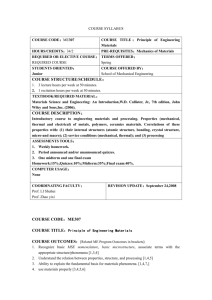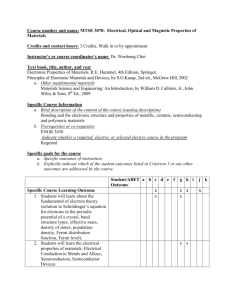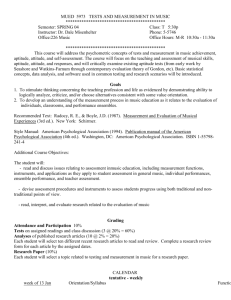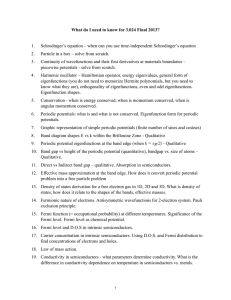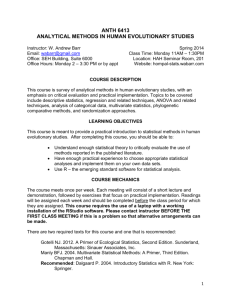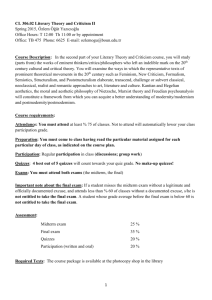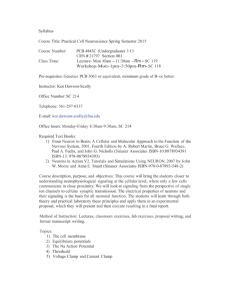Physics 425, Condensed Matter Physics
advertisement
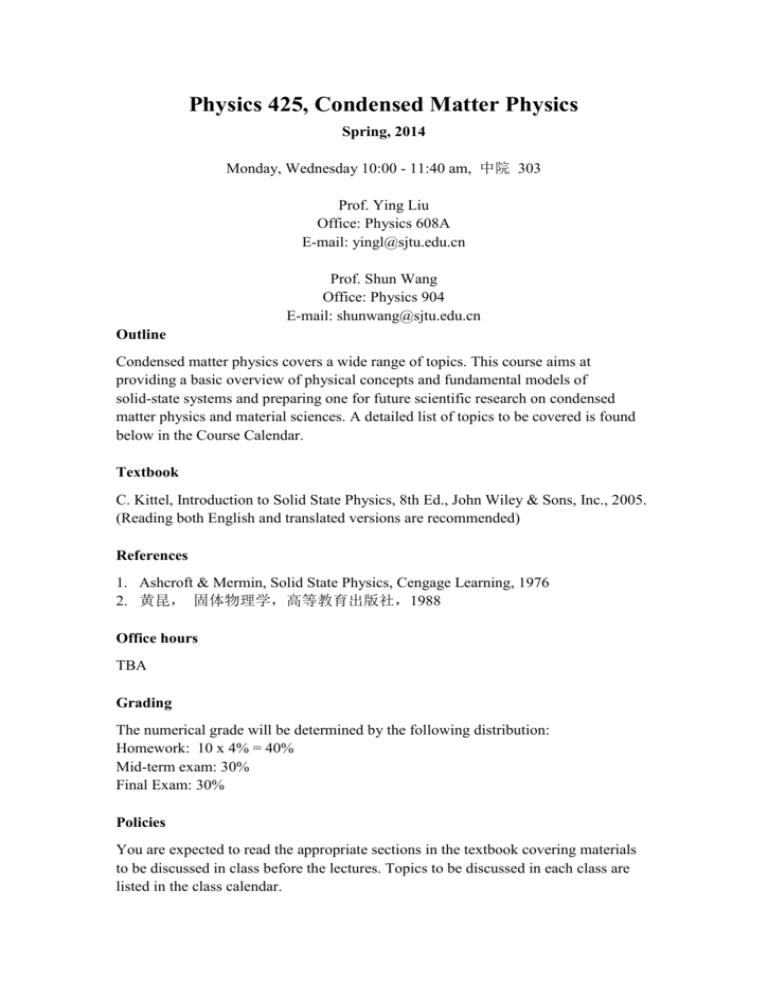
Physics 425, Condensed Matter Physics Spring, 2014 Monday, Wednesday 10:00 - 11:40 am, 中院 303 Prof. Ying Liu Office: Physics 608A E-mail: yingl@sjtu.edu.cn Prof. Shun Wang Office: Physics 904 E-mail: shunwang@sjtu.edu.cn Outline Condensed matter physics covers a wide range of topics. This course aims at providing a basic overview of physical concepts and fundamental models of solid-state systems and preparing one for future scientific research on condensed matter physics and material sciences. A detailed list of topics to be covered is found below in the Course Calendar. Textbook C. Kittel, Introduction to Solid State Physics, 8th Ed., John Wiley & Sons, Inc., 2005. (Reading both English and translated versions are recommended) References 1. Ashcroft & Mermin, Solid State Physics, Cengage Learning, 1976 2. 黄昆, 固体物理学,高等教育出版社,1988 Office hours TBA Grading The numerical grade will be determined by the following distribution: Homework: 10 x 4% = 40% Mid-term exam: 30% Final Exam: 30% Policies You are expected to read the appropriate sections in the textbook covering materials to be discussed in class before the lectures. Topics to be discussed in each class are listed in the class calendar. No late homework will be accepted and no make-up exams for missed exams will be offered unless you have valid excuse, family emergency, or illness, in which case you will need to present the written proof to the instructor in person in order to receive credit for late homework. Course Calendar: Date Content Homework Week 1 (Feb. 24 & 26) Introduction to the course, crystals, lattices, diffraction, experimental determination of crystal structures Homework Set 1: Crystal Structures Due: March 5 Week 2 (Mar. 3 & 5) Reciprocal lattices, structural factors, van der Waals, ionic, covalent and metallic bonding Homework Set 2: Diffraction, reciprocal lattices, crystal biding Due: March 12 Week 3 (Mar. 10 & 12) Lattice vibrations with monatomic and two-atom basis, phonons Homework Set 3: Lattice vibration and phonons Due: March 19 Week 4 (Mar. 17 & 19) Einstein and Debye model, thermal expansion, thermal conductivity Homework Set 4: Heat capacity of lattice vibration Due: March 26 Week 5 (Mar. 24 & 26) Free electron Fermi gas, heat capacity, electrical conductivity, Hall effect, thermal conductivity Homework Set 5: Free electron gas Due: April 2 Week 6 (Mar. 31 & Apr. 2) Energy bands, nearly free electron model, Bloch theorem, metals and insulators Homework Set 6: Electron transport and periodic potential, Due: April 9 Week 7 (Apr. 7 [No class, Holiday] & 9) Semiconductors, equation of motion, effective mass, Si and Ge, Week 8 (Apr. 14 & 16) Doping, Oxide, layered, and organic semiconductors Review Week 9 (Apr. 21 & 23) Mid-term exam & semiconductor devices Week 10 (Apr. 28 & 30) Plasmons, polaritons and polarons, Week 11 (May 5 & 7) Fermi Surface, Calculation of energy bands: Tight banding methods, Week 12 (May 14) De Haas-van Alphen effects. Determination of the Fermi surface, Landau levels and integer quantum Hall effect 12 & Homework Set 7: Semiconductors. Due: April 23 Homework Set 8: Fermi Surface and landau levels Due: May 14 Week 13 (May 21) 19 & Introduction to superconductivity: Occurrence and Phenomena, Cooper pairing Week 14 (May 26 & 28) BCS theory, Long-range phase coherence and flux quantization and Josephson effect Week 15 (Jun. 2 [No class, Holiday] & 4) Langevin diamagnetism equation, quantum theory of diamagnetism, quantum theory of paramagnetism, ferromagnetic order Week 16 (Jun. 9 & 11) Magnons, ferrimagnetic order, antiferromagnetism, ferromagnetic domains; Review Homework Set 9: Superconductivity Due: June 4 Homework Set 10: Magnetism Due: Jun. 11

